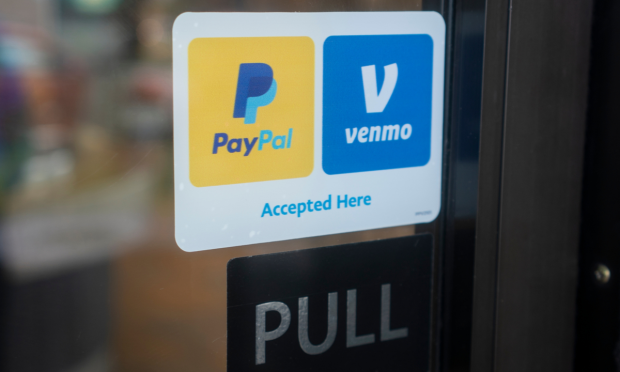Slowing growth. A churning of inactive accounts.
A slew of puts and takes dominated PayPal’s earnings Wednesday (Feb. 7), and a number of flat metrics sent investors headed, at least initially, for the exits in after-hours trading.
The stock was down 7% Wednesday evening.
Revenue rose 9% to $8 billion in the quarter, as calculated in constant currency.
As detailed in the supplemental materials, active accounts were down 2% year over year, and were down 0.6% sequentially, to a recent 426 million. Management attributed the results to a churn of unengaged accounts.
Monthly active accounts showed 1% growth to 224 million in the fourth quarter.
The decline in active accounts marks a change from the double-digit growth rates seen as recently as two fiscal years ago; the same can be said for the momentum in monthly active accounts.
Total number of payments transactions were up 13% to 6.8 billion, slowing from past years when the rates topped 20% and even 30%.
And digging into the total payment volumes, total branded checkout, at 30% of the tally, was up 5%.
Venmo saw 7% growth and person-to-person (P2P) transactions, excluding Venmo, lost 1% in the quarter, while declining 4% for the fiscal year.
Some Changes Needed
During the conference call with analysts, CEO Alex Chriss said that while the latest quarter’s results were “solid, we know there is still much room for improvement, and we are committed making the necessary changes to our business and how we invest and operate to get it right.” As part of that restructuring, as has been reported recently, the company is reducing its headcount.
The company in the meantime will be focused on accelerating growth in its branded checkout and improving overall profitability, Chriss said.
Where the Opportunities Lie
“2024 is going to be a transition year,” Chriss said, and will include “minimal contributions” from the recently announced innovations, detailed in earlier PYMNTS reporting, focused on faster checkout and “smart” receipts. Chriss reiterated that the new checkout features can reduce checkout times by around 40%. Risk-as-a-service, buy now pay later, and PayPal Complete Payments, he said, hold promise but will “take time to scale.”
Elsewhere he noted that the average revenue per account of someone who adopts the PayPal Cashback Mastercard is about five times higher than the average checkout-only account.
But only about 2% of active accounts have that card in their wallets, he said, and so it will remain an area of focus. About 6% of active Venmo customers have a Venmo debit card, so this represents what Chriss termed a “significant” opportunity.
“We will also leverage our merchant relationship and the power of AI to make the entire shopping experience personalized for consumers, while giving them control over their data,” Chriss said.
CFO Jamie Miller said on the call that transactions per active account were up 14% in the latest quarter, year over year, to 58.7. And in looking ahead, revenues are slated to grow by 7% in the current quarter, on a currency neutral basis. Full-year non-GAAP earnings will be in line with the prior year earnings, as transaction margins remain roughly flat.

